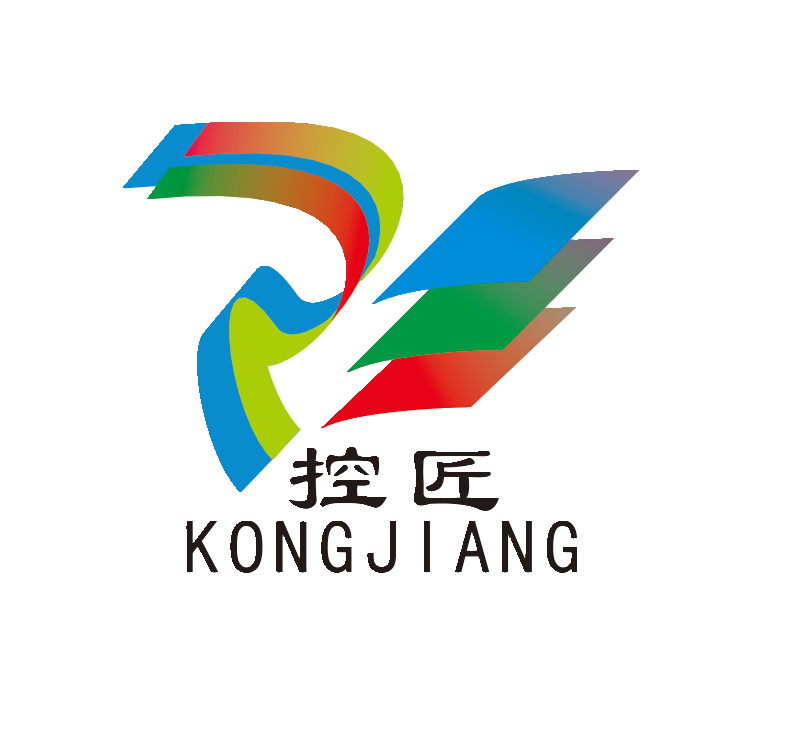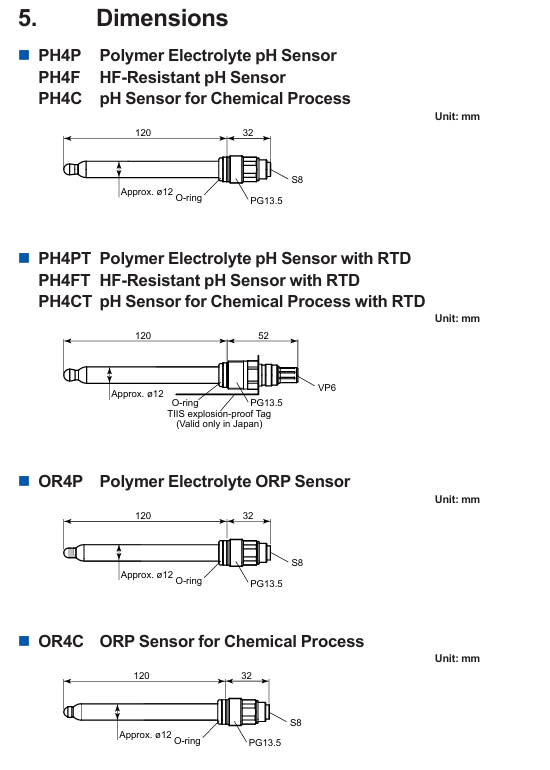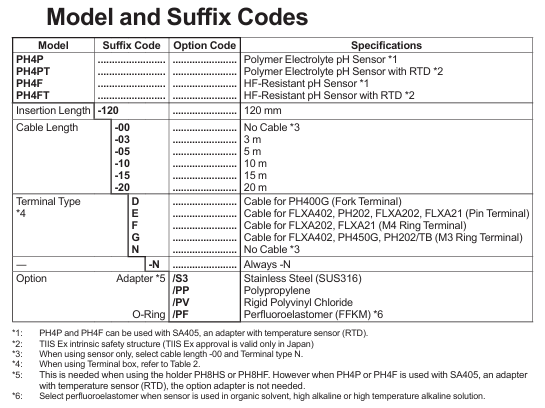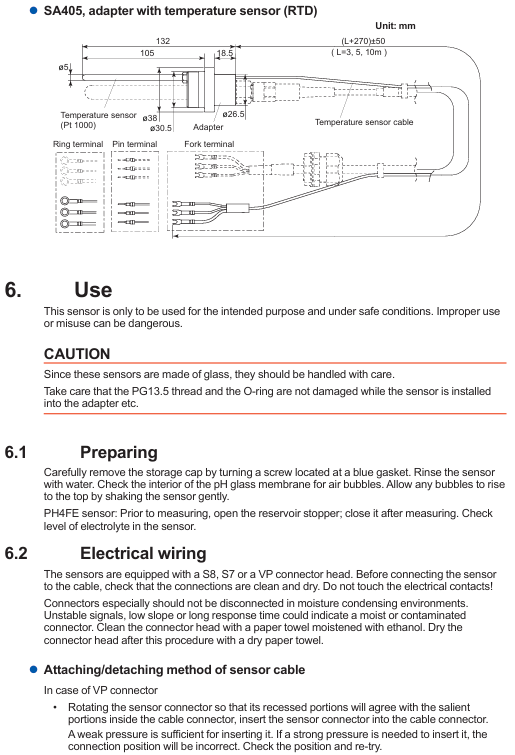

K-WANG


Yokogawa PH4/OR4 series pH and ORP sensor (IM12B10B00-01EN)
Yokogawa PH4/OR4 series pH and ORP sensor (IM12B10B00-01EN)
Product positioning and core series
1. Core positioning
PH4/OR4 series is a special electrochemical sensor designed for different severe working conditions. Through differentiated materials (such as HF resistant glass, perfluoroelastomer), electrolyte type (polymer electrolyte, high viscosity gel) and structure (built-in RTD, pressurized design), the PH4/OR4 series can solve the measurement stability problem of ordinary sensors under strong corrosion, high temperature, high viscosity and other scenarios. At the same time, it is compatible with mainstream transmitters in Yokogawa to meet industrial reliability requirements.
2. Series models and applicable scenarios
The series includes 9 sub models, classified according to measurement parameters (pH/ORP) and adaptability to working conditions. The core differences are as follows:
Model Series Type Core Features Applicable Scenarios
PH4P/PH4PT polymer electrolyte pH sensor with built-in polymer electrolyte (including KCl), no risk of liquid leakage; PH4PT with Pt1000 RTD (temperature compensation); General scenarios (such as municipal sewage and neutral solutions), without the need for frequent electrolyte replenishment;
The PH4F/PH4FT anti HF corrosion pH sensor is made of anti HF glass material, which can withstand low pH (2-11) and HF concentration (≤ 500 ppm at pH 2); PH4FT with RTD; Scenarios containing hydrofluoric acid (such as semiconductor cleaning, fluorine chemical industry);
PH4C/PH4CT special chemical pH sensor has a wide pH range (0~14) and built-in pressurized gel electrolyte (initial 250 kPa) to prevent medium infiltration; PH4CT with RTD; Strong acid-base and high viscosity media (such as chemical reaction vessels and acid-base neutralization processes);
OR4P/OR4C ORP sensor OR4P (polymer electrolyte, platinum wire electrode), OR4C (pressurized gel, platinum ring electrode); OR4P: Universal oxidation-reduction scenarios (such as wastewater treatment and disinfection); OR4C: Pollution prone scenarios (such as sulfide containing solutions);
PH4FE fermentation specific pH sensor long axis design (120/200mm), open electrolyte replenishment port, suitable for deep measurement in fermentation tanks; The biological fermentation process (such as pharmaceutical and food fermentation) requires regular replenishment of electrolytes;

Detailed explanation of technical specifications
1. Basic measurement parameters
Parameter category specification details (taking typical models as examples)
PH measurement range: PH4P/PH4CT 0~14 pH, PH4F 2~11 pH;
Accuracy: Slope ≥ 96% (25 ℃), asymmetric potential ± 15 mV;
Response time: t ₉₀<15 seconds (pH 7 → 4 step);
ORP measurement range: -1500~+1500 mV;
Electrode material: OR4P (platinum wire), OR4C (platinum ring);
Reference system: Ag/AgCl (containing KCl electrolyte);
Temperature adaptation without RTD model: -20~70 ℃ (ambient), process temperature varies from 0~105 ℃ depending on the model;
Model with RTD (such as PH4PT): Built in Pt1000 (-20~200 ℃) for temperature compensation;
Pressure adapted atmospheric pressure model (PH4P/PH4F): maximum immersion depth of 3m;
Pressure model (PH4C/OR4C): Initial pressure of 250 kPa, gradually decreasing with use, to avoid process pressure exceeding the internal pressure of the sensor;
Contact material body: borosilicate glass/HF resistant glass;
Electrolyte: PH4P (polymer), PH4C (high viscosity gel) PH4FE(3M KCl-LR);
Sealing components: Fluororubber (FPM)/Perfluoroelastomer (FFKM, optional/PF);
There is no clear IP rating for protection and installation, and it is necessary to cooperate with brackets (such as PH8HS/PH8HF) to achieve waterproofing; The installation angle should be ≥ 15 ° (horizontal upward) to avoid residual bubbles; Prohibit outdoor or pipe hanging use;
2. Key operating condition limitations
Some models have strict operating conditions restrictions, and when selecting, special attention should be paid to:
PH4F/PH4FT (anti HF): The upper limit of HF concentration increases with pH (500 ppm at pH 2, 10000 ppm at pH 4), and the upper limit of temperature is 80 ℃;
PH4C/PH4CT/OR4C (pressurized): The process pressure should be ≤ the internal pressure of the sensor (initial 250 kPa), and the internal pressure can be determined by the "gas layer length" of the thin tube inside the sensor (the shorter the gas layer, the higher the internal pressure);
PH4FE (fermentation specific): Only compatible with customized brackets, prohibited from being paired with PH8HS/PH8HF universal brackets, and the electrolyte replenishment port should be regularly opened to check the liquid level;
Selection guide: Model and suffix code
1. Core selection dimensions
The selection should clarify the three dimensions of measurement parameters (pH/ORP), operating conditions (temperature/pressure/corrosiveness of the medium), and supporting equipment (transmitter/bracket). After prioritizing the matching model, the detailed configuration should be determined through suffix codes:
Example of key considerations for selection dimensions (such as chemical HF scenarios)
Choose PH4 series for pH measurement parameters and OR4 series for ORP measurement parameters; PH measurement with HF → PH4F;
If the temperature compensation fluctuates greatly (>5 ℃), choose the RTD model (such as PH4FT), otherwise choose the basic model (such as PH4F); Process temperature fluctuates between 20~80 ℃ → PH4FT;
For the installation bracket, choose PH8HS for immersion type and PH8HF for flow type, which require corresponding adapters (such as S3 stainless steel adapter); Pipeline installation → PH8HF bracket+PH4F+/S3 (stainless steel adapter, acid resistant);
Cable and terminal cable length (03=3m, 05=5m, etc.), terminal type matching transmitter (such as E-pin terminal compatible with FLXA202); Transmitter distance sensor 5m → PH4FT-05-E;
Choose FFKM (/PF) as the sealing material for organic solvents/high-temperature alkali, and fluororubber (default) for ordinary scenarios; Scenario containing ethanol → PH4F+/PF;
2. Meaning of suffix codes
The suffix code is used to determine the adapter material, cable length, terminal type, seal and other details of the sensor. The core code meaning is as follows:
Core options for suffix code classification
/S3//PP/PV adapter material/S3 (SUS316 stainless steel, acid resistant),/PP (polypropylene, neutral scenario),/PV (rigid polyvinyl chloride, low-cost);
/HPV//TN special adapter/HPV (heat-resistant polyvinyl chloride, upper limit of 80 ℃),/TN (titanium material, strong corrosion scenario);
/PF sealing material is perfluoroelastomer (FFKM), suitable for organic solvents and high-temperature alkalis (such as NaOH solution above 80 ℃);
-The cable length numbers such as 03/-05/-10 represent the length (unit: m), such as -03=3m, with a maximum length of 20m; -00 indicates no cable (terminal box required);
D/E/F/G terminal types D (fork shaped terminal, compatible with PH400G), E (pin terminal, compatible with FLXA202), F/G (ring terminal, compatible with FLXA21);

Installation and wiring process
1. Preparation before installation
(1) Unpacking and Inspection
Confirm that the appearance of the sensor is undamaged (glass body, cable without cracks), and the model and suffix code (such as PH4F-05-E/S3) are consistent with the order;
Check the integrity of attachments: storage cap (including protective liquid), O-ring (default fluororubber, optional/PF), adapter (such as/S3);
When removing the storage cap, use a screwdriver to unscrew the screw at the blue gasket to avoid damaging the glass electrode; Check the "gas layer length" of PH4C/OR4C (confirm that the internal pressure is normal).
(2) Installation site selection requirements
Avoid areas where bubbles gather (such as at the top of pipelines), dead zones, or locations with high flow rates (>2 m/s) to prevent response delays or electrode wear;
Anti HF models (PH4F/PH4FT) should be kept away from strong oxidizing media (such as concentrated nitric acid) to avoid accelerated glass corrosion;
The installation in hazardous areas must comply with the IEC 60079-14 standard, and as a "simple device", it should be matched with an isolated transmitter (such as FLXA202) with a grounding resistance of ≤ 1 Ω.
2. Core installation steps (taking the flow bracket PH8HF as an example)
(1) Adapter and O-ring assembly
Select adapter: Choose the material based on the corrosiveness of the medium (such as S3 stainless steel adapter for acidic medium), and insert the O-ring (default FPM or optional/PF) into the adapter groove;
Pre installed sensor: Thread the sensor through the bracket fixing nut, insert the adapter, and ensure that the glass electrode is completely in contact with the medium channel (without air residue);
Tighten and fix: Tighten the nut clockwise to the O-ring compression seal (to avoid damaging the glass due to over tightening). For medium pressure models (PH4C/OR4C), it is necessary to confirm that the process pressure is ≤ the internal pressure of the sensor.
(2) Cable and terminal connection
The sensor cable contains 4-5 core wires (with an additional 1 core for RTD models), which need to be connected to the transmitter (such as FLXA202) according to the terminal definition. The wiring method is consistent for different terminal types:
Cable core function corresponding terminal (FLXA202 as an example) Remarks
The pH/ORP indicator electrode (GE) transmits measurement signals to terminal 15, ensuring that the wiring is secure and avoiding interference;
The reference electrode (RE) terminal 13 forms a circuit with the indicator electrode and needs to be grounded separately;
The grounding electrode (SE) terminal 14 must eliminate the grounding potential difference and be reliably grounded (grounding resistance ≤ 1 Ω);
RTD (T1/T2, with RTD model) terminals 11/12 are only available for PH4PT/PH4FT/PH4CT and are used for temperature compensation;
VP connector operation: Rotate the sensor connector to align the groove with the cable connector protrusion, gently insert and tighten the nut (only tighten the plastic part to avoid glass damage);
Terminal box usage: WTB10 terminal box is required for long-distance installation (>10m), with a total cable length of ≤ 20m to avoid signal attenuation.
Operations and Calibration
1. Daily maintenance
(1) Electrolyte replenishment and replacement
PH4P/PH4F/OR4P (polymer/gel type): there is no need to supplement electrolyte, and the sensor is replaced as a whole after its service life expires (usually 1-2 years);
PH4C/OR4C (pressurized type): The initial internal pressure is 250 kPa, which drops to about 125 kPa after 1 year of use. If the process pressure exceeds the internal pressure and the medium infiltrates, causing the sensor to fail, it needs to be replaced in advance;
PH4FE (fermentation specific): Regularly open the electrolyte replenishment port and replenish 3M KCl-LR solution to the liquid level line to avoid dry burning.
(2) Electrode cleaning
Choose the cleaning method based on the type of medium contamination, only clean the sensor tip (to avoid damaging the cable/connector):
Inorganic dirt (scale, salt): Use a soft cloth dipped in 1-2% dilute hydrochloric acid to wipe, and then rinse with pure water;
Organic dirt (oil, biofilm): Soak in neutral detergent solution (30 minutes to 2 hours), or use protease solution (such as hydrochloric acid solution containing gastric protease) in fermentation scenarios;
ORP electrode oxidation: Use a soft cloth dipped in toothpaste (mild abrasive) to wipe the platinum wire/platinum ring to remove the oxide layer.
2. Calibration process
(1) PH sensor calibration (two-point calibration method)
Prepare buffer solution: Select two points that are close to the process pH (such as pH 4.01+6.87, or pH 6.87+9.18), with the same temperature as the process;
Clean the sensor: Rinse the sensor with pure water to absorb surface moisture (avoid dilution with buffer solution);
First point calibration: Immerse in the first buffer solution (such as pH 6.87), wait for the reading to stabilize, and then follow the transmitter (such as FLXA202) prompts to perform "zero point calibration";
Second point calibration: Rinse with pure water and immerse in a second buffer solution (such as pH 4.01), perform "slope calibration", and ensure that the slope is ≥ 96%;
Verification: After calibration, return the first buffer solution with an error of ≤ 0.02 pH. Otherwise, clean and calibrate again.
(2) ORP Sensor Calibration (Quinone Hydroquinone Standard Method)
Prepare standard solution: Dissolve 1g of quinone hydroquinone powder in 200mL of pH 7.00 buffer solution and stir until saturated;
Calibration operation: Immerse the ORP sensor in a standard solution, wait for the reading to stabilize, and then enter the theoretical value according to the transmitter prompt (ORP=88 mV, rH=23.6 at pH 7);
Error allowance: Calibration error ≤ ± 10 mV. If it exceeds the tolerance, the platinum electrode needs to be cleaned and recalibrated.
3. Storage and regeneration
Short term storage (<1 month): Put on a storage cap and inject 1.5-2mL of 3.3M KCl solution to avoid electrode drying;
Long term storage (>1 month): It is recommended to replace the storage solution every 3 months to prevent electrolyte deterioration;
Sensor regeneration: If the sensor is dry or the response slows down, the pH sensor can be soaked in 0.1M NaOH (10 minutes) → 0.1M HCl (10 minutes) → 3.3M KCl (15 minutes); Clean the platinum surface of ORP sensor with abrasive.

- YOKOGAWA
- Energy Access
- Renewable Integration
- Energy Subsidies
- Energy and Water
- Net zero emission
- Energy Security
- Critical Minerals
- A-B
- petroleum
- Mine scale
- Energy and Gender
- Covid-19
- man-machine
- Reliance
- ADVANCED
- SEW
- ProSoft
- WATLOW
- Kongsberg
- FANUC
- VSD
- DCS
- PLC
- Sewage treatment
- cement
- Yaskawa
- Woodward
- BOSCH Rexroth
- MOOG
- General Electric
- American NI
- Rolls-Royce
- CTI
- Honeywell
- EMERSON
- xYCOM
- Construction site
- Siemens
- architecture
- Industrial information
- New energy
- Automobile market
- electricity
- Motorola
- HIMA
- ABB
- Rockwell
- Schneider Modicon
- MAN
- GE
- TRICONEX
- Control Wave
- ALSTOM
- AMAT
- STUDER
- KONGSBERG
- MOTOROLA
- DANAHER MOTION
- Bentley
- Galil
- EATON
- MOLEX
- Triconex
- DEIF
- B&W
- ZYGO
- Aerotech
- DANFOSS
- KOLLMORGEN
- Beijer
- Endress+Hauser
- schneider
- Foxboro
- KB
- REXROTH
-
Kollmorgen S33GNNA-RNNM-00 - Brushless Servo Motor
-
Kollmorgen 6sm56-s3000-g-s3-1325 - Servo Motor
-
Kollmorgen AKM52K-CCCN2-00 - Servo Motor
-
Kollmorgen PSR3-230/75-21-202 - Power Supply
-
Kollmorgen akm24d-anc2r-00 - Servo Motor
-
Kollmorgen AKM22E-ANCNR-00 - Servo Motor
-
Kollmorgen S60300-550 - Servo Drive
-
Kollmorgen B-204-B-21 - Servomotor
-
Kollmorgen AKM21E-BNBN1-00 - Servo Motor
-
Kollmorgen TT2953-1010-B - DC Servo Motor
-
Kollmorgen pa8500 - Servo Power Supply
-
Kollmorgen BDS4A-210J-0001-207C2 - Servo Drive
-
Kollmorgen TTRB1-4234-3064-AA - DC Servo Motor
-
Kollmorgen MH-827-A-43 - Servo Motor
-
Kollmorgen AKM24D-ACBNR-OO - Servo Motor
-
Kollmorgen 00-01207-002 - Servo Disk DC Motor
-
Kollmorgen AKM21C-ANBNAB-00 - Servo Motor
-
Kollmorgen PSR3-208/50-01-003 - Power Supply
-
Kollmorgen 6SM56-S3000 - Servo Motor
-
Kollmorgen DBL3H00130-B3M-000-S40 - Servo Motor
-
Kollmorgen 6SN37L-4000 - Servo Motor
-
Kollmorgen AKM65K-ACCNR-00 - Servo motor
-
Kollmorgen 6SM56-L3000-G - Servo Motor
-
Kollmorgen AKMH43H-CCCNRE5K - Servo Motor
-
Kollmorgen PSR4/52858300 - Power Supply
-
Kollmorgen KBM-79H03-E03 - Direct Drive Rotary Motor
-
Kollmorgen AKM33E-ANCNDA00 - Servo Motor
-
Kollmorgen U9M4/9FA4T/M23 - ServoDisc DC Motor
-
Kollmorgen AKM13C-ANCNR-00 - Servo Motor
-
Kollmorgen AKM43L-ACD2CA00 - Servo Motor
-
Kollmorgen AKM54K-CCCN2-00 - Servo Motor
-
Kollmorgen M-605-B-B1-B3 - Servo Motor
-
Kollmorgen AKD-P00606-NBAN-0000 - Rotary Drive
-
Kollmorgen 6SM-37M-6.000 - Servo Motor
-
Kollmorgen A.F.031.5 - Sercos Interface Board
-
Kollmorgen 918974 5054 - Servo PWM
-
Kollmorgen U12M4 - ServoDisc DC Motor
-
Kollmorgen AKD-B00606-NBAN-0000 - Servo Drive
-
Kollmorgen MV65WKS-CE310/22PB - Servo Drive
-
Kollmorgen 65WKS-CE310/22PB - Servo Drive
-
Kollmorgen EM10-27 - Module
-
Kollmorgen S64001 - Servo Drive
-
Kollmorgen CR03200-000000 - Servo Drive
-
Kollmorgen 6SM57M-3000+G - Servo Motor
-
Kollmorgen BDS4 - Servo Drive
-
Kollmorgen AKD-P00306-NBEC-000 - Servo Drive
-
Kollmorgen AKD-B01206-NBAN-0000 - Servo Drive
-
Kollmorgen STP-57D301 - Stepper Motor
-
Kollmorgen 6SM37L-4.000 - Servo Motor
-
Kollmorgen 44-10193-001 - Circuit Board
-
Kollmorgen PRDR9SP24SHA-12 - Board
-
Kollmorgen PRD-AMPE25EA-00 - Servo Drive
-
Kollmorgen DBL3N00130-0R2-000-S40 - Servo Motor
-
Kollmorgen S406BA-SE - Servo Drive
-
Kollmorgen AKD-P00607-NBEI-0000 - Servo Drive
-
Kollmorgen AKD-P01207-NBEC-0000 - Servo Drive
-
Kollmorgen CR03550 - Servo Drive
-
Kollmorgen VSA24-0012/1804J-20-042E - Servo Drive
-
Kollmorgen N2-AKM23D-B2C-10L-5B-4-MF1-FT1E-C0 - Actuator
-
Kollmorgen 04S-M60/12-PB - Servo Drive
-
Kollmorgen H33NLHP-LNW-NS50 - Stepper Motor
-
Kollmorgen A-78771 - Interlock Board
-
Kollmorgen AKM43E-SSSSS-06 - Servo Motor
-
Kollmorgen AKD-P00607-NBEC-0000 - Servo Drive
-
Kollmorgen E21NCHT-LNN-NS-00 - Stepper Motor
-
Kollmorgen cr10704 - Servo Drive
-
Kollmorgen d101a-93-1215-001 - Motor
-
Kollmorgen BDS4A-203J-0001-EB202B21P - Servo Drive
-
Kollmorgen MCSS23-6432-002 - Connector
-
Kollmorgen AKD-P01207-NACC-D065 - Servo Drive
-
Kollmorgen CK-S200-IP-AC-TB - I/O Adapter and Connector
-
Kollmorgen CR10260 - Servo Drive
-
Kollmorgen EC3-AKM42G-C2R-70-04A-200-MP2-FC2-C0 - Actuator
-
Kollmorgen BDS5A-206-01010-205B2-030 - Servo Drive
-
Kollmorgen s2350-vts - Servo Drive
-
Kollmorgen AKM24D-ANC2DB-00 - Servo Motor
-
Kollmorgen E31NCHT-LNN-NS-01 - Stepper Motor
-
Kollmorgen PRD-0051AMPF-Y0 - Servo Board
-
Kollmorgen TB03500 - Module
-
Kollmorgen 60WKS-M240/06-PB - Servo Drive
-
Kollmorgen M21NRXC-LNN-NS-00 - Stepper Motor
-
Kollmorgen H-344H-0212 - Servo Motor
-
Kollmorgen MCSS08-3232-001 - Connector
-
Kollmorgen AKM33H-ANCNC-00 - Servo Motor
-
Kollmorgen PA-2800 - Power Supply
-
Kollmorgen MTC308C1-R1C1 - Servo Motor
-
Kollmorgen PRDR0091300Z-00 - Capacitor Board
-
Kollmorgen BDS4A-206J-0024/01502D79 - Servo Drive
-
Kollmorgen S20330-VTS - Servo Drive
-
Kollmorgen S20250-CNS - Servo Drive
-
Kollmorgen SBD2-20-1105-WO - Servo Drive Board
-
Kollmorgen M405-C-A1--E1 - Servo Motor
-
Kollmorgen PRD-PB805EDD-00 - Servo Drive
-
Kollmorgen 6SM57S-3.000-J-09-HA-IN - Servo Motor
-
Kollmorgen AKM33H-ANCNDA-00 - Servo Motor
-
Kollmorgen PCB-00030200-04 - PCB
-
Kollmorgen H22SSLB-LNN-NS-02 - Stepper Motor
-
Kollmorgen BJRL-20012-110001 - Module
-
Kollmorgen BDS4A-206J-0001404A - Servo Drive
-
Kollmorgen H-342-H-0802 - Servo Motor
-
Kollmorgen CR10561 - Servo Drive
-
Kollmorgen BDS5A-206-00010-205B2-030 - Servo Drive
-
Kollmorgen BDS5A-206-00010-207B-2-030 - Servo Drive
-
Kollmorgen mcss08-3224-001 - Connector
-
Kollmorgen M-207-B-23-B3 - Servo Motor
-
Kollmorgen PRD-0041200Z-S0 - Encoder/Resolver Card
-
Kollmorgen MH-225-G-61 - Motor
-
Kollmorgen MT308B1-T1C1 - Servo Motor
-
Kollmorgen BDS4A-240J-0001604C83 - Servo Drive
-
Kollmorgen 6SM57-S-3000 - Servo Motor
-
Kollmorgen N-T31V-15-5B-6-MF3-FT1E-C251 - Actuator
-
Kollmorgen PRD-0051AMPA-X0 - Servo Board
-
Kollmorgen CF-SS-RHGE-09 - Cable
-
Kollmorgen DIGIFAS7204 - Servo Drive
-
Kollmorgen S30101-NA - Servo Drive
-
Kollmorgen DIGIFAS7201 - Servo Drive
-
Kollmorgen PRD-0051AMPA-Y0 - Servo Board
-
Kollmorgen AKM23D-EFCNC-00 - Servo Motor
-
Kollmorgen SE10000 - Servo Drive
-
Kollmorgen PSR4/5A-112-0400 - Power Supply
-
Kollmorgen AKM31H-ANCNC-01 - Servo Motor
-
Kollmorgen M-203-B-93-027 - Servo Motor
-
Kollmorgen CP-SS-G1HE-05 - Connector
-
Kollmorgen AKM42G-ASCNR-02 - Servo Motor
-
Kollmorgen DBL4N00750-B3M-000-S40 - Servo Motor
-
Kollmorgen R3-BK23-152B-12-PL-ASE-BS115 - Actuator
-
Kollmorgen MH-427-B-61 - Motor
-
Kollmorgen cr06902 - Servo Drive




